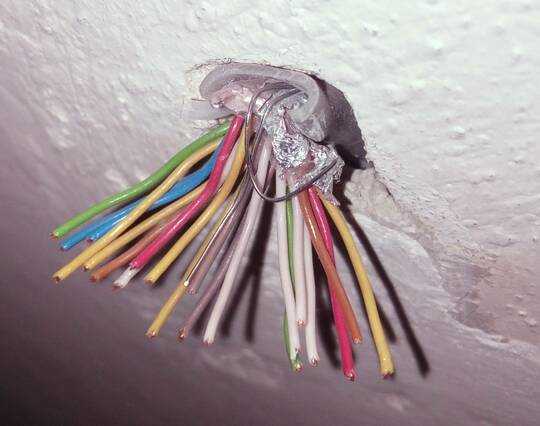Internet vs. telephone cable. How can I tell them apart? Which of them is this one?
Answers
1
If the building is old, it's likely the phone wire has been in place much longer than the network wire, if in fact there's network at all. You may be able to distinguish that way -- older wire (usually four, but occasionally only two insulated conductors in a single sheath) is for telephone. Ethernet will have at least six, commonly eight conductors in a sheath, and is likely to be newer, as it will have been retrofitted.
The wire in the photo looks like a multiplex cable, carrying (potentially) up to five ethernet sets or telephone sets -- there are multiples of most color codes, though I can't see five of every color so it's hard to be sure. That complicates matters, because they'll need to be traced back to (at least) a breakout box before you can be sure which set you're designated to use, even after you're sure which type of wire it is.
0
thats gona be hard and it depends alot of your country but for phone is mostly red green yellow and black or brown
hope this one here might help youWiring for rj11-14(telephone)
and you can also find out of that with a multimeter wiring diagram for rj45(internet)
0
This looks like an old-school 10-pair cable from a business phone system from the 1970's or early 80's.
Before the advent of digital phone systems, each function a typical office phone could handle required its own pair of wires. Each line required a pair, as did placing a call on hold, parking a call, the intercom feature, transferring a call to another line (required two pairs), etc.
On top of all that, the little indicator lights on the phone itself also needed their own pair. In very old office buildings that have not been renovated in a long time, it's not uncommon to dig out a massive 48-pair cable in the wall running to what used to be the secretary's desk, since her phone was the one that had probably three or four lines and she was transferring/placing calls on hold all day long.
In light of all that complicated cabling, it's easy to see why digital phones replaced analog systems almost overnight.
A modern twisted pair cable has a maximum of 4 pairs, but digital voice-only phone lines could get by with just one.

No way based on that picture. An internet (LAN) cable has 8 small cables, a phone cable probably 4; just looking the picture it's impossible to identify them. – Máté Juhász – 2016-07-29T12:04:06.483
Those wires are very thickand are solid core. Data wires tend to be thin and stranded core. Either it is for something custom, or something requiring a lot of power. A bell system perhaps. – spuder – 2016-07-29T13:45:13.517
You can assume that is telephone wire and not for Ethernet. Modern Ethernet uses twisted pair, aka UTP, and the insulation would clearly indicate the wire pairs (e.g. solid colors and striped). Those wires all seem to be solid colors. @spuder -- UTP can be stranded or solid wire. Patch cables are stranded, but in-wall or in-conduit use solid wire. You have no reference to estimate wire gauge. – sawdust – 2016-07-29T20:32:56.593
@spuder, "Data wires tend to be thin and stranded core." That depends. UTP patch cords are supposed to use stranded cable, but horizontal cable (in the wall) is required by standard to be solid-core. Horizontal solid-core cable can be up to 90 meters, and the stranded patch cords are allowed to be 5 meters on each end. Stranded cable is less likely to break, but its performance is poor compared to solid-core cable, which is more fragile. – Ron Maupin – 2016-07-29T23:38:13.250
Thank you all for help, I'm going to try to trace it back to breakout box to get more information. – janjaromirhorak – 2016-07-30T09:01:53.280
That appears to be part of a 25 pair cable if you ask me. – DrZoo – 2016-08-04T05:17:56.317